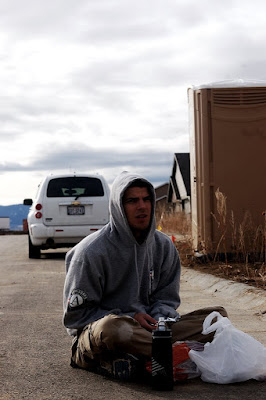



The site also featured a special exhibit called "Wedding Belles & Beaux" that gave a glimpse into marriage traditions of the 1900s. Several wedding dresses and gifts were on display, along with fun facts and informative displays. You can check out the entire exhibit online here.


The mansion was essentially one giant dollhouse trimmed and decorated to early 20th century perfection. The information was very well synthesized, and it was fun to fantasize about the rich and famous. Despite its size and grandeur, the place had a warm, homey feel with its dark wood panels, leaf-motif wallpaper, and rich, burgundy wool rugs. You can take a virtual tour of the house here.
After the mansion, we attended a Community Holiday Dinner at the local Holiday Inn. This local tradition provides a free meal to anyone in Sheridan and serves more than 2,000 people annually. It is hosted by the local chamber of commerce with the help of generous donations from the local businesses. We had a really great dinner of turkey with gravy, stuffing, and cranberry sauce, green beans, broccoli, salad, and a roll, followed by ice cream and coffee. It wasn't a fancy ordeal, but it was festive and filling.


The following day, we drove north across state lines to Little Bighorn Battlefield National Monument in Montana. I'd of course heard of Custer's Last Stand but really had no idea what it was about or why it was important. The actual events of the day are notoriously complicated and controversial, but the decisive victory by the Native Americans was the beginning of the end for the indigenous Plains Indians. Despite their overwhelming win, the battle turned the full wrath of the U.S. against the Native Americans and their way of life.



We watched an informative orientation video that briefly went over the events of the battle, and it was really cool to go outside and look out over the hills knowing that we were on the exact site where the fighting took place. In the visitors center, there was a small but interesting exhibit about the times and culture, along with dioramas, timelines, and artifacts taken straight off the battlefield.



We took a road tour through the battlefield, following along in our trail map and brochure to figure out where all the important sites were. Large portions of the site have been turned into a national cemetery to mark where soldiers fell. My very favorite part of the trip was visiting the Indian Memorial, a relatively new addition that honors the Indians on both the Indian and U.S. sides who died in battle. It's a really unique and beautiful piece unlike any that I'd seen before.








The weather was freezing with the wind chill putting temperatures well below zero, so we actually saw most of the site from the warmth of the van. It was so cold that after literally just two minutes outside, the cold cut painfully through four layers of thermal, fleece and down, making my whole body numb. The hilly terrain was beautiful but monotonous; it was really not much different than what we saw along the drive up, but the history made the area significant. On the way home, we stopped for lunch at a trading post which sold souvenirs and hot food. I had some traditional Native American fry bread, which tastes a bit like a beignet, along with creamy potato soup with big chunks of ham. It was greasy, but perfectly filling and incredibly tasty.



To complete our weekend, one of the board members from the local Habitat for Humanity chapter invited us over to his home for dinner. He and his wife live in the far-flung outskirts of Sheridan; we had to follow a guide down winding, snow-covered roads to find the cozy little house, which the couple built themselves. It was a very warm and cozy evening, with an enormous dinner of fragrant pot roast with mashed potatoes and carrots and an apple crisp and pumpkin pie a la mode for dessert. From what I've seen, I've come to the conclusion that everyone in Sheridan lives in beautifully rustic lodging, and our hosts were absolutely delightful and inviting.



























